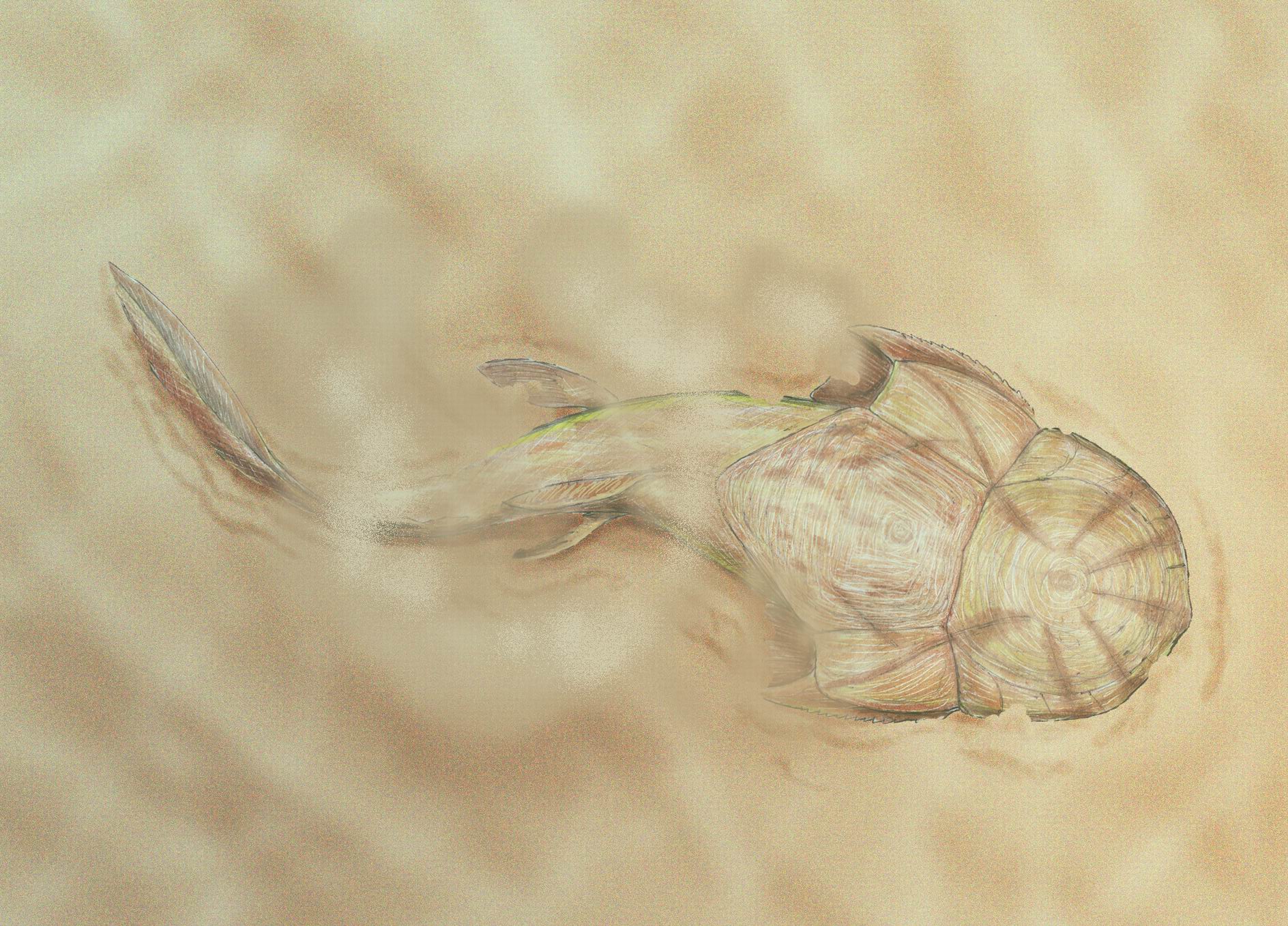Phyllolepida on:
[Wikipedia]
[Google]
[Amazon]
Phyllolepida ("leaf scales") is an  Despite having a relatively clear idea of the phyllolepids' lifestyle and anatomy, most fossils consist of fragments of their
Despite having a relatively clear idea of the phyllolepids' lifestyle and anatomy, most fossils consist of fragments of their
extinct
Extinction is the termination of an organism by the death of its Endling, last member. A taxon may become Functional extinction, functionally extinct before the death of its last member if it loses the capacity to Reproduction, reproduce and ...
taxon
In biology, a taxon (back-formation from ''taxonomy''; : taxa) is a group of one or more populations of an organism or organisms seen by taxonomists to form a unit. Although neither is required, a taxon is usually known by a particular name and ...
of flattened placoderms found throughout the world, with fossils being found in Devonian
The Devonian ( ) is a period (geology), geologic period and system (stratigraphy), system of the Paleozoic era (geology), era during the Phanerozoic eon (geology), eon, spanning 60.3 million years from the end of the preceding Silurian per ...
strata
In geology and related fields, a stratum (: strata) is a layer of Rock (geology), rock or sediment characterized by certain Lithology, lithologic properties or attributes that distinguish it from adjacent layers from which it is separated by v ...
. Like other flattened placoderms, the phyllolepids were bottom-dwelling predator
Predation is a biological interaction in which one organism, the predator, kills and eats another organism, its prey. It is one of a family of common List of feeding behaviours, feeding behaviours that includes parasitism and micropredation ...
s that ambushed prey. Unlike other flattened placoderms, the phyllolepids were inhabitants of freshwater environments.
Unlike the Rhenanida, the armor of the phyllolepids were made of whole plates, rather than numerous tubercles and scales, and unlike the Petalichthyida, the components of the comparatively wide mouth are known. The phyllolepids are considered to have been blind, as the orbits for the eyes are extremely small, so much so as to suggest that the eyes were vestigial, and that they were placed on the sides of the head, as opposed to visually-oriented bottom-dwelling predators, like, say stargazers or flatfish
A flatfish is a member of the Ray-finned fish, ray-finned demersal fish Order (biology), suborder Pleuronectoidei, also called the Heterosomata. In many species, both eyes lie on one side of the head, one or the other migrating through or around ...
, which have the eyes placed high on top of the head.
 Despite having a relatively clear idea of the phyllolepids' lifestyle and anatomy, most fossils consist of fragments of their
Despite having a relatively clear idea of the phyllolepids' lifestyle and anatomy, most fossils consist of fragments of their thoracic
The thorax (: thoraces or thoraxes) or chest is a part of the anatomy of mammals and other tetrapod animals located between the neck and the abdomen.
In insects, crustaceans, and the extinct trilobites, the thorax is one of the three main ...
armor, and only two genera
Genus (; : genera ) is a taxonomic rank above species and below family as used in the biological classification of living and fossil organisms as well as viruses. In binomial nomenclature, the genus name forms the first part of the binomial s ...
, '' Phyllolepis'' and '' Austrophyllolepis'' have been thoroughly studied. From the articulation of the thoracic and head plates, it has been suggested that they are either the sister group of order Arthrodira, or are in fact, a group of highly derived arthrodires.
Taxonomy
The Phyllolepids are divided into twofamilies
Family (from ) is a group of people related either by consanguinity (by recognized birth) or affinity (by marriage or other relationship). It forms the basis for social order. Ideally, families offer predictability, structure, and safety as ...
, the more primitive Gavinaspididae, represented only by '' Gavinaspis'' of Early Devonian China
China, officially the People's Republic of China (PRC), is a country in East Asia. With population of China, a population exceeding 1.4 billion, it is the list of countries by population (United Nations), second-most populous country after ...
, and Phyllolepididae, which contains all other genera. Barring the Chinese ''Gavinaspis'', the cosmopolitan '' Placolepis'' (fossils of which have been found in Australia, Turkey
Turkey, officially the Republic of Türkiye, is a country mainly located in Anatolia in West Asia, with a relatively small part called East Thrace in Southeast Europe. It borders the Black Sea to the north; Georgia (country), Georgia, Armen ...
, Venezuela
Venezuela, officially the Bolivarian Republic of Venezuela, is a country on the northern coast of South America, consisting of a continental landmass and many Federal Dependencies of Venezuela, islands and islets in the Caribbean Sea. It com ...
, and Antarctica
Antarctica () is Earth's southernmost and least-populated continent. Situated almost entirely south of the Antarctic Circle and surrounded by the Southern Ocean (also known as the Antarctic Ocean), it contains the geographic South Pole. ...
), and the Euro-North American '' Phyllolepis'', the majority of genera are found in Early to Middle Devonian Australia
Australia, officially the Commonwealth of Australia, is a country comprising mainland Australia, the mainland of the Australia (continent), Australian continent, the island of Tasmania and list of islands of Australia, numerous smaller isl ...
. By the Famennian, only ''Phyllolepis'' survived, and became extinct at the close of the Devonian.
References
Long, John A. The Rise of Fishes: 500 Million Years of Evolution Baltimore: The Johns Hopkins University Press, 1996. Placoderm orders {{Placoderm-stub